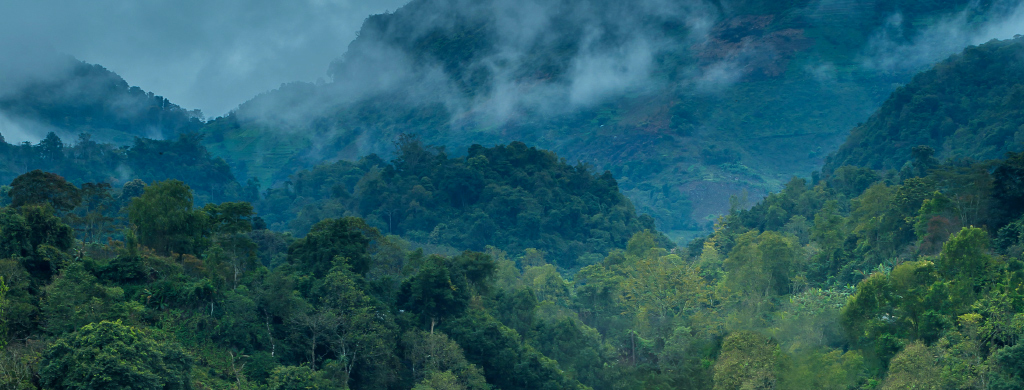Want to steep some happiness into your day? There’s a tea for that. If you’ve browsed through our newest straight tea collection, chances are you’ve come across our Happy Valley Darjeeling. This flavourful black tea draws its unique aromas from the terroir of India’s Happy Valley – a renowned tea garden at the foot of the Himalayas. From its fruity notes of ripe plum and apricot to its pleasant astringency, it’ll put just about anyone in a good mood. In fact, we love this loose leaf tea so much, we sent our DAVIDsTEA tea team straight to the source to uncover the secret behind what makes their darjeeling so darn delicious (hint: it’s all about the tea garden).
DT explores the Happy Valley Tea Estate

Left to right: Laura Wordingham (Tea Category Merchant) and Marie-Claude Dessureault (Head of Tea) learn how to pluck darjeeling tea leaves with Happy Valley tea pluckers.
Did you know the Happy Valley Tea Estate is the highest tea garden in Darjeeling, India? It’s located at 6,900 ft above sea level. Our DT team got a taste of the region’s cool and misty April climate when they took part in the harvesting of the First Flush darjeeling. Not gonna lie – we’re a tad jealous of our coworkers right now.
“As soon as we set foot in this lush tea garden, we could see why it was called Happy Valley,” said Marie-Claude Dessureault, Head of Tea at the DAVIDsTEA Store Support Centre in Montreal. “Everyone was so smiley and happy to show us around the tea factory where the delicate tea leaves are processed. We even had the pleasure of doing a tasting with some of the employees. You could taste the pride they put into preparing this rare and unique tea.”
To make 1 kg of regular darjeeling tea, it takes about 20,000 leaves and buds. And to make 1 kg of this Specialty First Flush, it takes 75,000! Talk about a labour of love.
During their Happy Valley tour, our tea team formed a mutual bond with one of the tasters over – what else? – chocolate tea.

First Flush darjeeling leaves growing in the Happy Valley garden
“He told us his dream would be to taste chocolate tea,” said Dessureault, who happened to have a few 12 Tea Samplers stashed in her backpack and pulled a chocolaty one out right away. “It was a great moment. Sharing our pride and passion with people making our teas is such an important part of being in this trade.”
Established in 1854, Happy Valley is Darjeeling’s second oldest tea estate. Fun fact? It’s recognized as being the first organic tea garden in India! So it’s no wonder we were excited to get our hands on such a unique tea from the master of exquisite darjeeling varieties.
The difference between first and second flush darjeeling

Gearing up for a private tea tasting at the Happy Valley Tea Estate in India.
Darjeeling has four tea flushes in total: First Flush, Second Flush, Monsoon Teas and Autumn Flush. But the two most popular types are the First and Second Flush darjeelings, which are more complex in flavour and harvested in the spring and early summer months – like our Happy Valley Darjeeling tea. So what’s the difference between the two? Here’s the flavour breakdown:
1st Flush Darjeeling (late February to mid-April) – Fresh and fragrant floral aroma, lively and lightly astringent. Delicate and fragile, with grey-green sheen on the tea leaves. Steeps a light green-yellow liquor.
2nd Flush Darjeeling (May to June) – Full-bodied, muscatel-flavoured cup with a mellow astringency and mature fruity notes. Tea leaves are luscious with shimmering buds and steep a gorgeous amber liquor. The tell-tale plum and apricot notes of our Happy Valley Darjeeling give its coveted second-flush provenance away.
A tea garden that gives back to the community

Two village girls walking through the streets of Happy Valley’s rural community.
Not only does Happy Valley produce amazing tea, its owners are also firm believers in social responsibility. This awesome tea plantation helps support the livelihood of its mostly female tea producers and their families in these and other ways:
- Free education facilities
- Free housing
- Free medical facilities
- Continuity of employment
- Infant Nutrition Program
- Income Augmentation Program
- Fair Trade Practices
A tea that tastes great AND gives back? Sign us up! One sip of Happy Valley Darjeeling and you’ll be smiling from ear to ear. But don’t wait too long – this beautiful tea is only here for a limited time.



